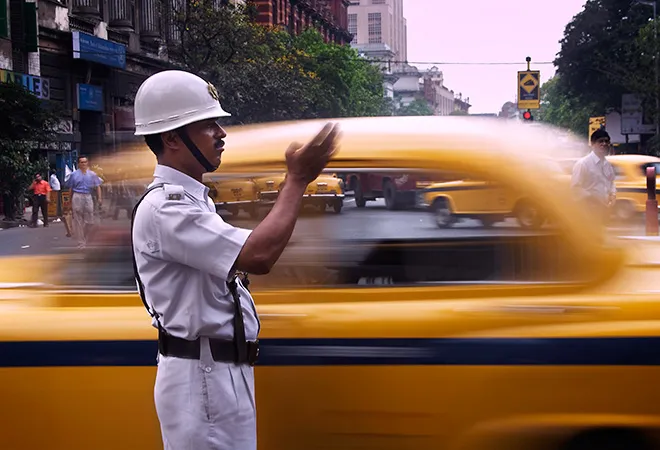
The Motor Vehicles (Amendment) Act, 2019 has been generating great acrimony and debate across the country. The Act has, among other things, steeply revised traffic violation fines that were fixed in 1988. The most significant are penalties of ₹10,000 (up from ₹2,000) for drunken driving, ₹5,000 (up from ₹1,000) for rash driving, ₹5,000 (up from ₹500) for driving without license, ₹2,000 (up from ₹400) for over-speeding and ₹1,000 (up from ₹100) for not wearing a seat belt or helmet.
According to the Union Minister of Road Transport & Highways (MoRTH), the key objective is not to garner revenue but to save lives and inject a dose of discipline in the driving habits of a large number of Indians who routinely flout traffic rules. In India, “five lakh accidents take place, 1.5 lakh people lose their lives.. which is the highest in the world,” he observed. Justifying the increase in penalties, he said: “30 years back, the fine which was ₹100, how much should it be today? I don’t need to tell you the value of rupee now and then.”
In certain cases, unbelievably hefty fines have been collected — ostensibly for multiple types of violations committed simultaneously — that is bound to cause angst among citizens.
It would be fairly accurate to say that those parts of the country that have begun implementing the law have had modestly positive results in terms of driving conduct. A heightened fear of law generally seems to have been generated among the driving population. However, in certain cases, unbelievably hefty fines have been collected (ostensibly for multiple types of violations committed simultaneously) that is bound to cause angst among citizens. Added to this is the anxiety of poor drivers who earn a measly monthly salary of around ₹10,000 ending up paying a large percentage of their salary as fine.
These and other concerns have led several states to approach these amendments with caution. Rajasthan would like to mull over the fairness of these fines before allowing their application. Gujarat has slashed the proposed fines, some of them by 90 percent. West Bengal has voiced its dissent against manifold hike in penalties. Punjab, Madhya Pradesh and Telangana appear to be in no mood to implement the revision. Goa, Andhra Pradesh, Uttar Pradesh, Tripura and Chhattisgarh have followed suit. Even Maharashtra has bought time and sent the matter back to the Centre for reconsideration.
The massive resistance put up by the states is bound to raise the question whether the Act was passed in haste without wide and meaningful consultation. This has been rebutted by the Union minister, who has clarified that the original draft was prepared by 20 transport ministers. It went to a joint select committee of Parliament and then to a standing committee. The bill was also discussed in both houses of Parliament before it became law.
WHO’s Global Report on Road Safety 2018 states that a total of 150,785 people lost their lives in road accidents in India in 2017. This was indeed the highest in the world.
This article wishes to look into certain aspects of the Act that may have missed being highlighted, but have a significant bearing on the subject. The minister arguing his case, set the objective of saving lives and bringing discipline in driving behavior as his primary goals. He also added that the fines set in 1988 needed to be brought in line with the current value of the rupee.
A word on each of these arguments should be in order. WHO’s Global Report on Road Safety 2018 states that a total of 1, 50,785 people lost their lives in road accidents in India in 2017. This was indeed the highest in the world. A more comparable figure, however, from the same source would be 22.6 deaths per 100,000 population. There are 54 countries with a higher road death rate. This is merely to put the cited observation into perspective, not to refute the very high casualties in India. More importantly, the MoRTH set a target of reducing road fatalities to 50 percent by 2020. There was a small drop of 1.9 per cent of road deaths in 2017 compared to 2016, with death figures going down from 150,785 to 147,193. One would have to see what impact the implementation of the Motor Vehicles (Amendment) Act 2019 has on these figures in the coming years. On the face of it, the target is a steep hill to climb.
Over-speeding and drunken driving that figure at the top of the causes of road casualties, will attract penalties of ₹1,000-2,000 and ₹10,000 respectively, just five times the earlier fines of ₹400 and ₹2,000.
The minister’s assertion about the depreciation of the value of rupee and recalibrating fines seems spot on. The current value of ₹100 is estimated to be ₹911.63 or roughly one-tenth of its value in 1988. In other words, the purchasing power of ₹100 in 1988 equals ₹911.76 today. Hence a ten-fold increase in fines would be in order. Unfortunately, this logic does not seem to have been evenly applied, especially if the prime objective is to save lives. For instance, not wearing a helmet or seat belt, a relatively mild offence, will now attract a penalty of ₹1,000, ten times higher than earlier ₹100. However, over-speeding and drunken driving that figure at the top of the causes of road casualties, will attract penalties of ₹1,000-2,000 and ₹10,000 respectively, just five times the earlier fines of ₹400 and ₹2,000. Apparently, the objectives and the fines have a weak co-relation.
Additionally, the objective of the ability to pay has not found much consideration. While the rupee has depreciated about 10 times in the last 30 years, there has not been a corresponding rise in earnings among the poor. There could have been two alternatives here that one could have looked at. For minor traffic offences, the penalty of commensurate community service could have been considered. For major ones, the example of some Scandinavian countries that link fines with income might have been a good option. This puts a larger onus on the rich to set an example of good civic behavior. In line with this, a distinction could also have been made among cars, three-wheelers and two-wheelers.
Since motor vehicles are concentrated in cities, it is natural that the focus would be on urban areas. However, urban roads form only 8.93 percent of all roads in the country.
While saving lives is a laudable objective, good driving habits alone are not enough to bring down deaths. Quality of roads, competence and freshness level of the driver, vehicle fitness, road engineering, clear and visible signage and citizen awareness, all come into play. Furthermore, road safety audits while designing roads and eliminating accident-prone spots on built roads are hugely significant. Designing safe roads requires large sums of money to be spent on safety features. Safe crossings, underpasses, viaducts and bright and frequent road signage on high speed roads improve safety. But in the search for more length of built roads, many such features that increase the likelihood of accidents are omitted.
Lastly, news in the media have mostly talked about the implementation of the Act in relation to cities and towns. Since motor vehicles are concentrated in cities, it is natural that the focus would be on urban areas. However, urban roads form only 8.93 percent of all roads in the country. Accident figures reveal that in 2017, 62.9 percent of deaths occurred on national and state highways and 37.1 percent on other roads. Over-speeding and overtaking were the top causes of road deaths, accounting for 66.7 percent of all fatalities. These figures make it quite clear that while cities are overpopulated with cars, road deaths primarily happen outside cities. However, the highways have skeletal manning by an overstretched police force. In the given situation, overzealous policing of traffic rules in the already existing urban chaos may achieve a modicum of urban driving discipline, but will have little impact on ‘saving lives’. One cannot but conclude that India over-legislates and under-implements.
The views expressed above belong to the author(s). ORF research and analyses now available on Telegram! Click here to access our curated content — blogs, longforms and interviews.




 PREV
PREV


